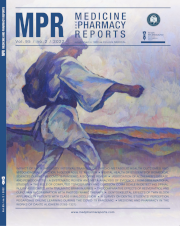Effect of the different chromatic filters of the dental operating microscope on the volumetric shrinkage, surface hardness, and depth of cure of bulk fill composite
DOI:
https://doi.org/10.15386/mpr-2012Keywords:
bulk fill composite, intensity, microscopic light filters, surface hardness, volumetric shrinkageAbstract
Aim. Evaluate the effect of different chromatic filters of the dental operating microscope on the volumetric shrinkage, surface micro-hardness, and depth of cure of bulk-fill composite.
Materials and methodology. Bulk fill composite specimens of 4 mm depth, 4 mm width, and 4 mm length were prepared. Five groups were designed based on a light source under which composite samples were condensed. Group 1: dental chair light without filter, Group 2: microscopic light without filter, Group 3: microscopic light with a yellow filter, Group 4: microscopic light with a green filter, Group 5: dental chair light with a red filter. After condensation, the samples were subjected to curing using Bluephase NM curing light. The parameters like volumetric shrinkage, surface hardness, and depth of cure were measured for all the samples. The results were subjected to statistical analysis using one-way ANOVA, followed by post-hoc Tukey tests.
Results. Group-2 showed the highest mean volumetric shrinkage (14.514%), surface micro-hardness (58.065 kg/m2), depth of cure (0.831%), whereas group-5 showed the least volumetric shrinkage (7.386%), surface micro-hardness (46.536 kg/m2), and depth of cure (0.789%). Working time was 40 seconds for group-2, whereas the remaining groups were allowed to complete 1-minute condensation. A statistically significant difference was shown between groups 1 and 5 (p=0.050), 2 and 5 (p=0.007) for volumetric shrinkage. Regarding surface micro-hardness, a statistically significant difference was observed between all the groups (p=0.001) except group-3, group-4 (p=0.100). There was no statistically significant difference between all the groups except group 2 and 5 for depth of cure (p=0.016).
Conclusion. Microscope light without filter showed the highest surface hardness and depth of cure. However, the highest volumetric shrinkage and lesser working time were also observed, which are undesirable. Use of filters during composite manipulation showed less detrimental effects on depth of cure, volumetric shrinkage and working time. Overall, composite condensed under filters showed acceptable properties.
Downloads
Published
How to Cite
Issue
Section
License
The authors are required to transfer the copyright of the published paper to the journal. This is done by agreeing to sign the Copyright Assignment Form. Whenever the case, authors are also required to send permissions to reproduce material (such as illustrations) from the copyright holder.

The papers published in the journal are licensed under a Creative Commons Attribution-NonCommercial-NoDerivatives 4.0 International License.

